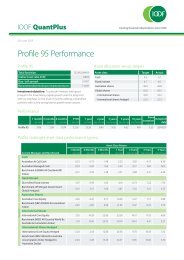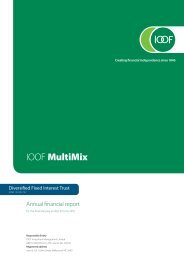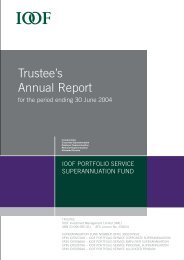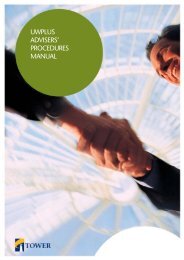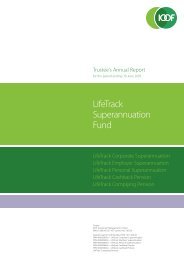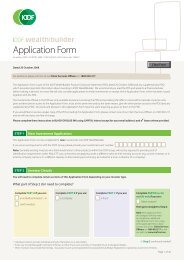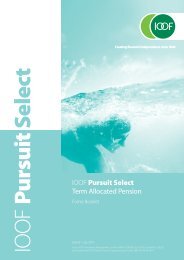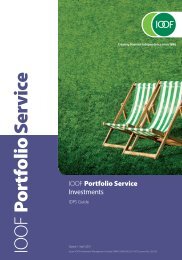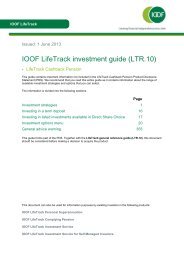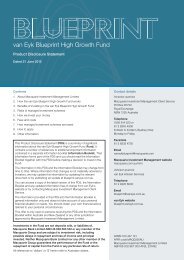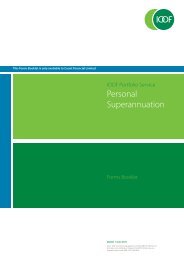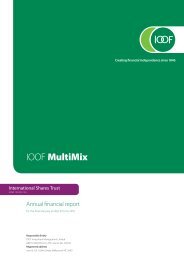annual report 2011
annual report 2011
annual report 2011
Create successful ePaper yourself
Turn your PDF publications into a flip-book with our unique Google optimized e-Paper software.
IOOF | <strong>annual</strong> <strong>report</strong> <strong>2011</strong><br />
Deferred tax is recognised in respect of temporary differences<br />
between the carrying amounts of assets and liabilities for<br />
financial <strong>report</strong>ing purposes and the amounts used for<br />
taxation purposes. Deferred tax is not recognised for the<br />
following temporary differences: the initial recognition of<br />
assets or liabilities in a transaction that is not a business<br />
combination and that affects neither accounting nor taxable<br />
profit or loss, and differences relating to investments in<br />
subsidiaries and associates to the extent that it is probable<br />
that they will not reverse in the foreseeable future. In<br />
addition, deferred tax is not recognised for taxable temporary<br />
differences arising on the initial recognition of goodwill.<br />
Deferred tax is measured at the tax rates that are expected to<br />
be applied to temporary differences when they reverse, based<br />
on the laws that have been enacted or substantively enacted<br />
by the <strong>report</strong>ing date.<br />
Deferred tax assets and liabilities are offset when there is<br />
a legally enforceable right to offset current tax assets and<br />
liabilities and when deferred tax balances relate to the same<br />
taxation authority. Current tax assets and liabilities are offset<br />
where the entity has a legally enforceable right to offset and<br />
intends either to settle on a net basis, or to realise the asset and<br />
settle the liability simultaneously.<br />
(i)<br />
Tax consolidation<br />
IOOF Holdings Ltd and its wholly owned Australian resident<br />
entities (including IOOF Ltd benefit funds) are part of a<br />
tax-consolidated group under Australian taxation law. As a<br />
consequence, all members of the tax-consolidated group are<br />
taxed as a single entity.<br />
Tax expense/income, deferred tax liabilities and deferred tax<br />
assets arising from temporary differences of the members of<br />
the tax-consolidated group are recognised in the separate<br />
financial statements of the members of the tax-consolidated<br />
group using the ‘separate taxpayer within group’ approach<br />
by reference to the carrying amounts in the separate financial<br />
statements of each entity and the tax values applying under<br />
tax consolidation. Current tax liabilities and assets and deferred<br />
tax assets arising from unused tax losses and relevant tax<br />
credits of the members of the tax-consolidated group are<br />
recognised by the Company (as head entity in the taxconsolidated<br />
group).<br />
Due to the existence of a tax funding arrangement between<br />
the entities in the tax-consolidated group, amounts are<br />
recognised as payable to or receivable by the company and<br />
each member of the group in relation to the tax contribution<br />
amounts paid or payable between the parent entity and the<br />
other members of the tax-consolidated group in accordance<br />
with the arrangement.<br />
Further information about the tax funding arrangement is<br />
detailed in note 11 to the financial statements.<br />
Where the tax contribution amount recognised by each<br />
member of the tax-consolidated group for a particular period<br />
is different to the aggregate of the current tax liability or asset<br />
and any deferred tax asset arising from unused tax losses<br />
and tax credits in respect of that period, the difference is<br />
recognised as a contribution from (or distribution to) equity<br />
participants.<br />
(ii)<br />
Uncertain Tax Position<br />
Tax Laws Amendment (2010 Measures No. 1) Bill 2010, received<br />
Royal Assent on 3 June 2010. The Act contains a number of<br />
amendments to the tax consolidation regime that deal with<br />
the recognition of tax cost setting amounts in the income<br />
tax law. A new section ( s 716-405) may provide a specific<br />
tax deduction for the tax cost setting amount on assets that<br />
qualify as rights to future income assets acquired upon an<br />
entity joining a tax consolidated group. The Company has<br />
analysed customer related intangibles, acquired as part of<br />
various acquistions the Company or its subsidiaries have made<br />
since 2005, with a view to applying the new provisions. The<br />
Company has sought a private ruling to confirm its entitlement<br />
to these tax deductions.<br />
On 30 March <strong>2011</strong>, the Board of Taxation was requested<br />
to undertake a review of these provisions and provide<br />
recommendations that may limit the use and scope<br />
these provisions . Such recommendations may have<br />
restrospective application. To date these recomendations<br />
have not been made public and it is uncertain as to how any<br />
recommendations will be legislated and applied.<br />
Until receipt of the private ruling and actionable<br />
recommendations from the Board of Taxation the tax effect<br />
of Tax Laws Amendment (2010 Measures No. 1) Bill 2010 is<br />
considered uncertain.<br />
(p) Goods and service tax (GST)<br />
Revenues, expenses and assets (excluding receivables) are<br />
recorded net of GST. GST input tax credits are initially recorded<br />
as an asset and GST collected as a liability. These balances<br />
are offset as at the <strong>report</strong>ing date and recognised as either<br />
an amount receivable or payable to the Australian Taxation<br />
Office. The GST portion relating to financial supplies and nondeductible<br />
expenditure, for which an input tax credit cannot<br />
be claimed, is expensed or is recognised as part of the cost of<br />
acquisition of an asset.<br />
Receivables and payables are stated inclusive of the amount of<br />
GST receivable or payable. The net amount of GST recoverable<br />
from, or payable to, the Australian Taxation Office is included<br />
page 63



